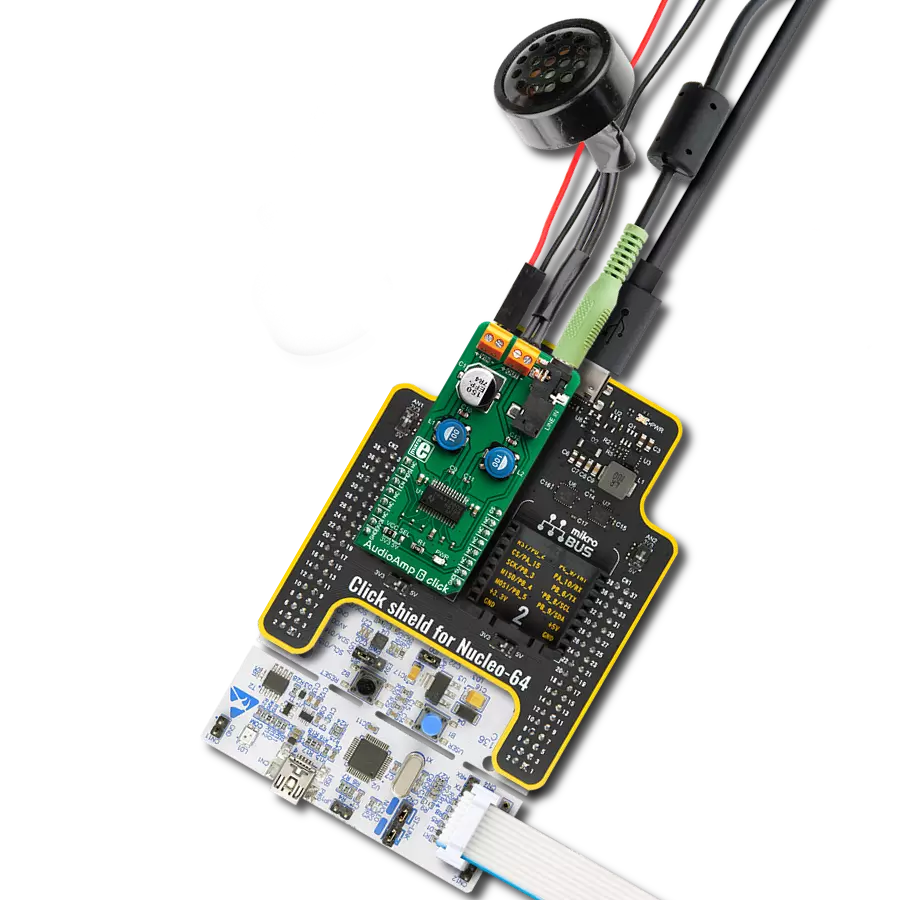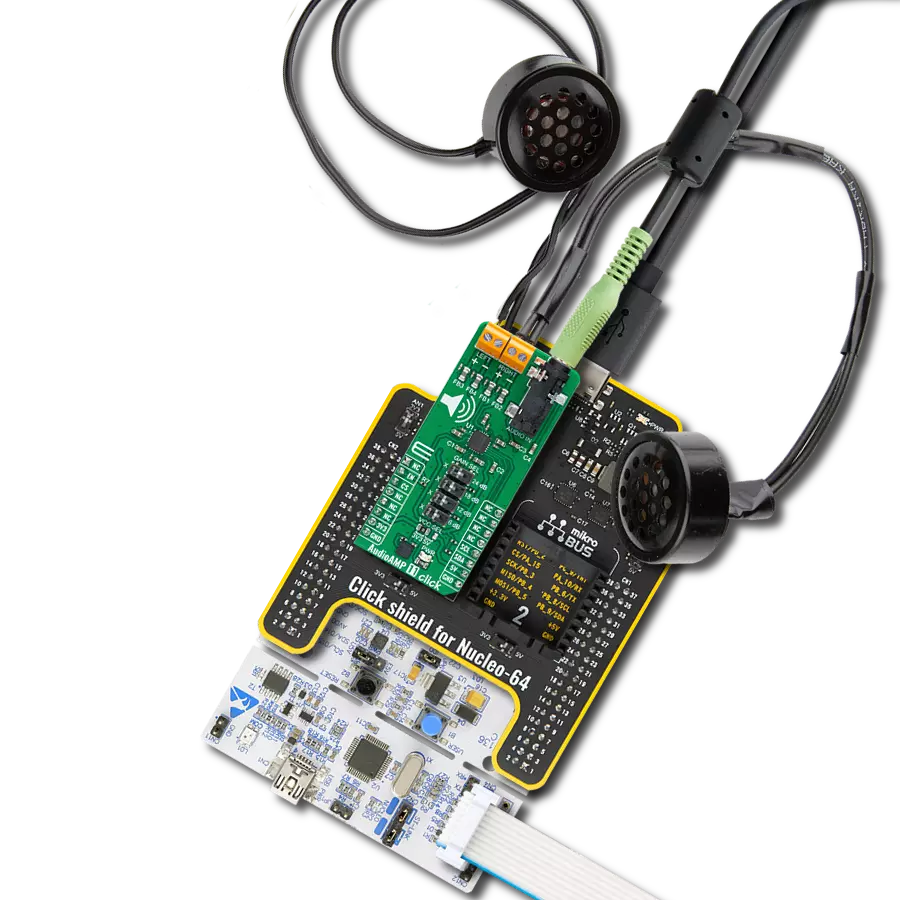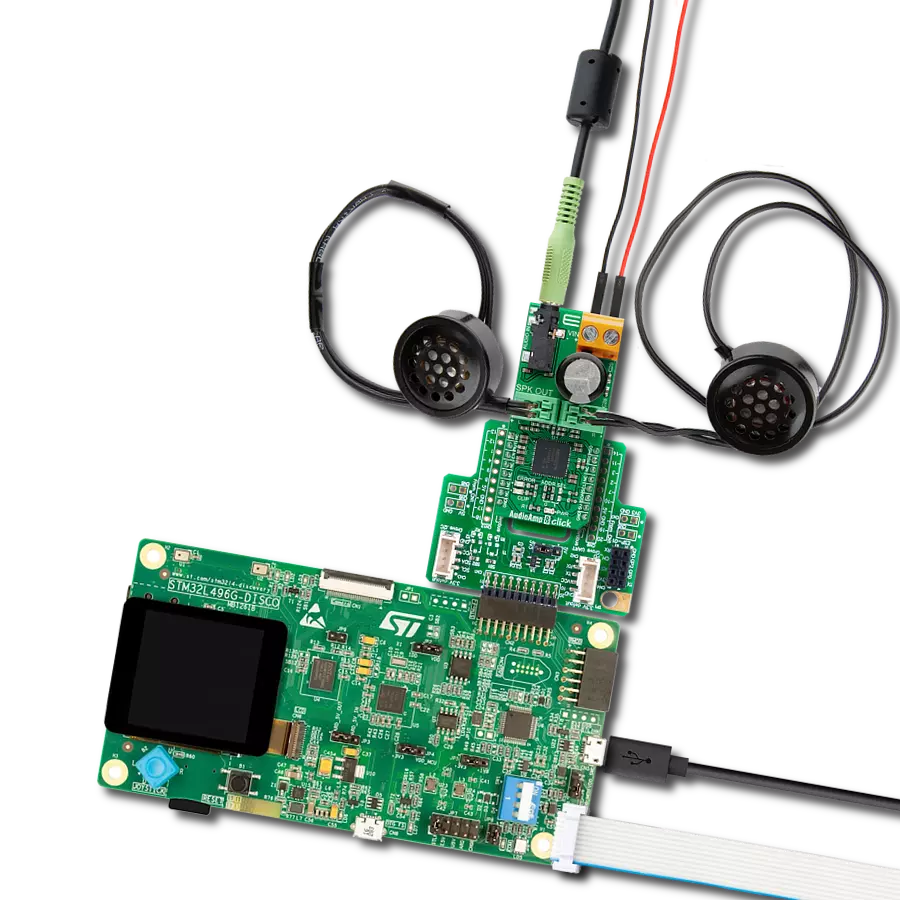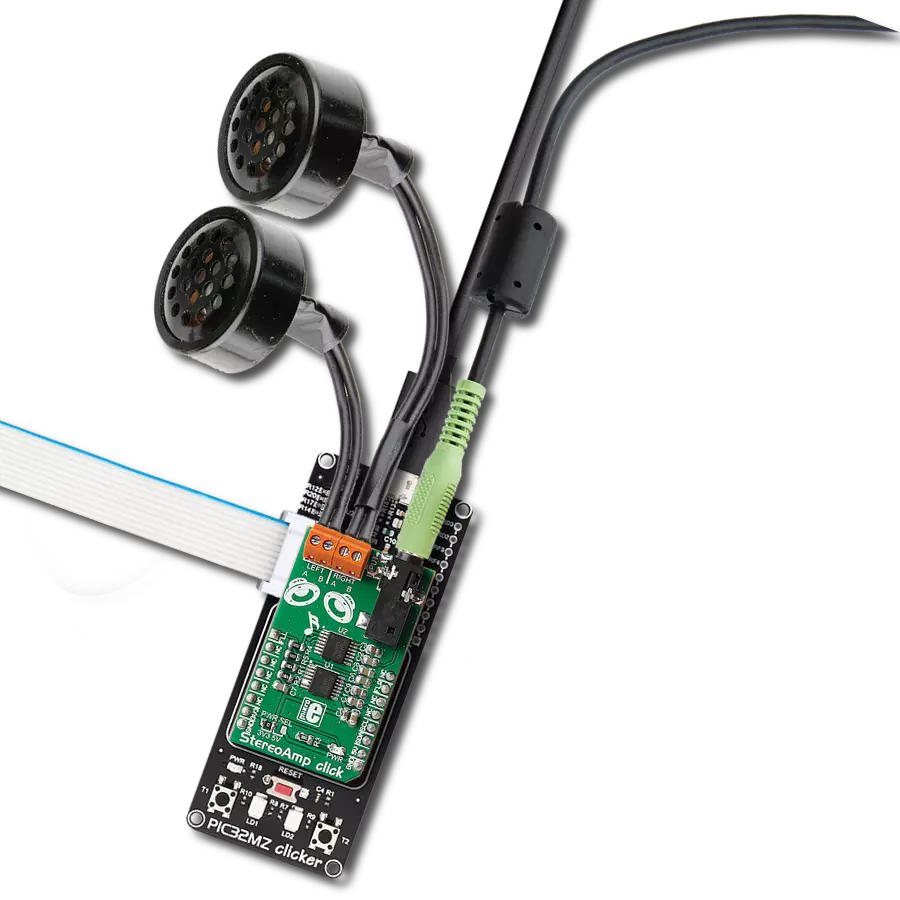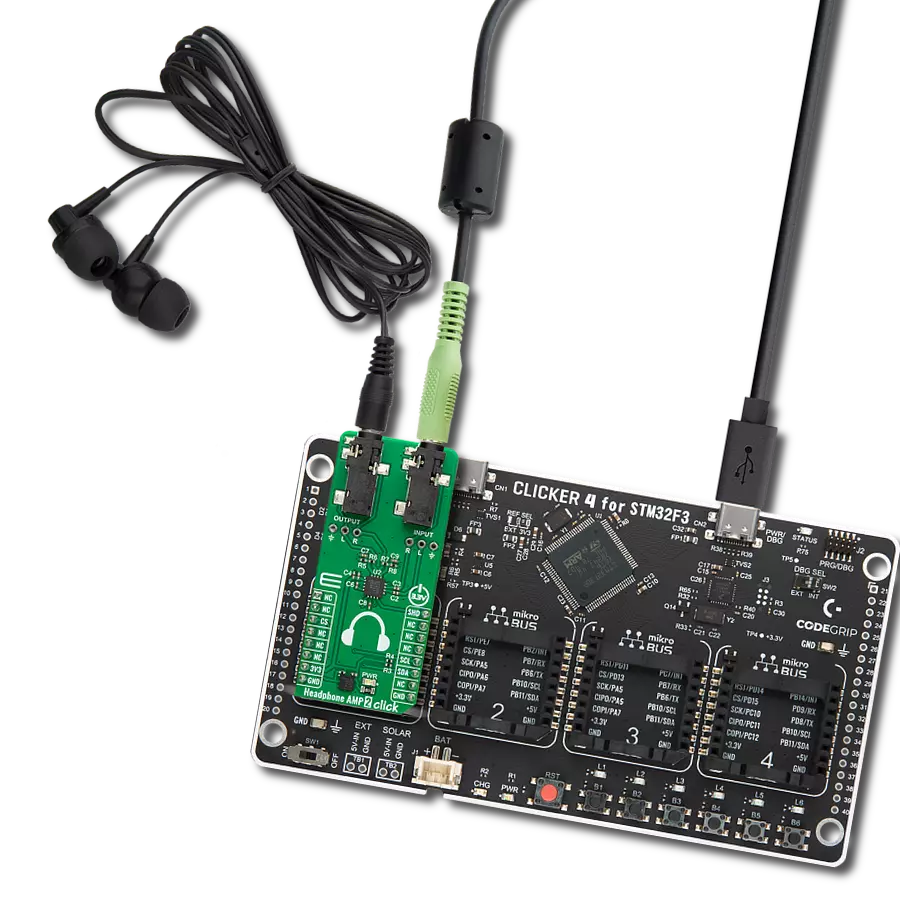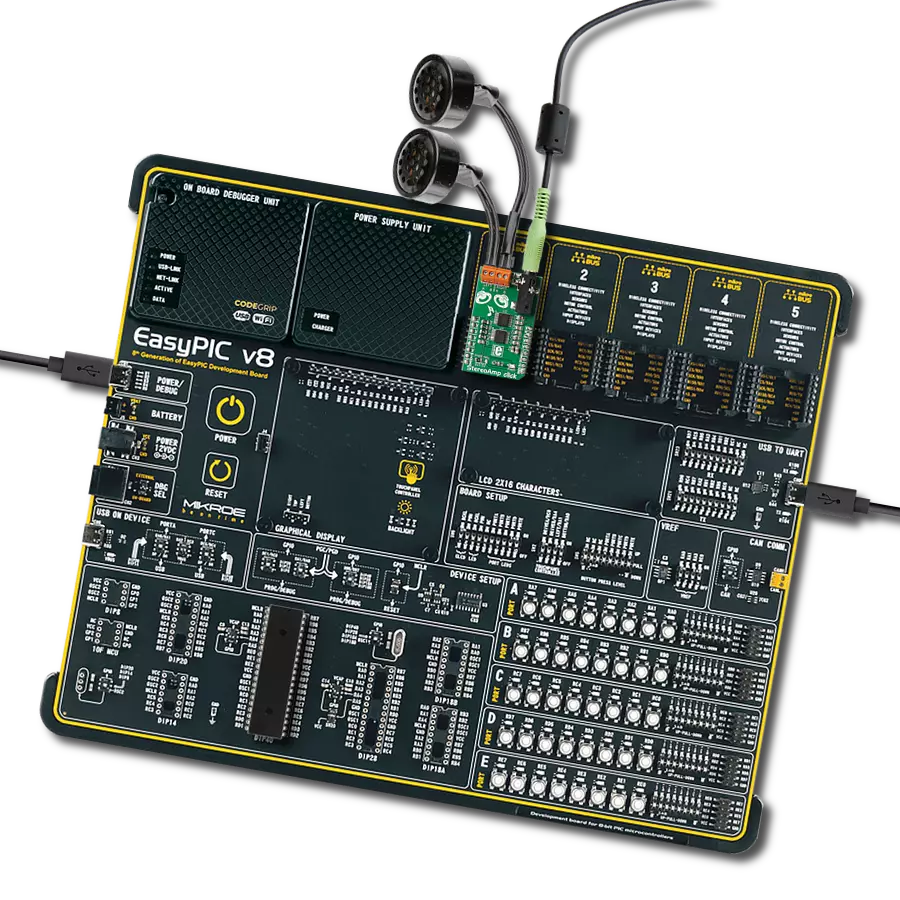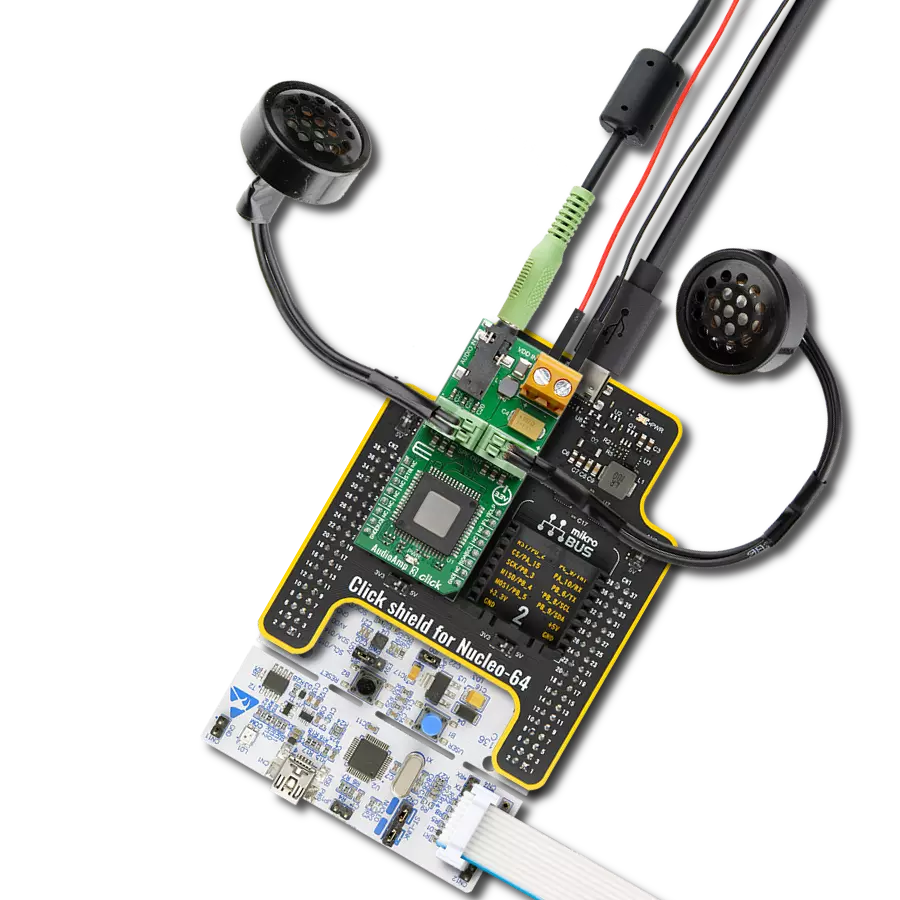Experience stereo brilliance and let our amplifier take your audio to new heights of clarity and depth
A
A
Hardware Overview
How does it work?
AudioAmp 3 Click is based on the TAS5414, an automotive stereo class-D audio amplifier from Texas Instruments. It has many features that make this IC a very attractive solution for stand-alone active speakers. It is very flexible regarding the PSU voltage: it can work with voltages within the range of 6V to 24V. Its nominal operating voltage used at the PSU connector (14.4V) can still deliver up to 28W of power per channel to 4Ω load. However, outputs can be paralleled (PBTL mode), reaching over 100W of power to the connected 2Ω speaker, with a low value of Total Harmonic Distortion (THD), at 24V power supply voltage. This Click board™ requires an external Power Supply Unit (PSU). It can use various power supply voltages, from 6V to 24V. AudioAmp 3 Click is a perfect solution for different kinds of active desktop speakers, battery-powered Bluetooth® and wireless speakers, TV sets and PC monitors, and other types of consumer audio equipment. Due to its high efficiency can even be used as a sound reinforcement solution for various IoT applications. The device communicates with the system processor via the I2C serial communication bus as an I2C slave-only device.
The processor can poll the device via I2C to determine the operating status. All fault conditions and detections are reported via I2C. Numerous features and operating conditions can also be set via I2C. The TAS5414 IC features a set of protections, including output short circuit, over-temperature, under-voltage, over-voltage protection, and more. These protections will be reported to the main MCU at the FLT pin if any of these are activated. The TAS5414 IC can also detect a constant DC current at the output. When a DC detection event occurs, the outputs are turned OFF, protecting the connected speakers. The output stage of the TAS5414 operates in Bridge-Tied Load (BTL) topology. This means there are two outputs per channel: inverted and non-inverted (OUTN and OUTP). Class-D amplifier produces the sound by modulating the pulse-with of the output voltage. While there is no input, OUTN and OUTP are in phase, with a 50% duty cycle. There is no current through the speaker in this case. The duty cycle will increase at the OUTP and decrease at the OUTN simultaneously when the positive half-phase of the audio signal is applied at the input. For the negative half-phase at the input, the opposite will happen.
The greater the difference in pulse width, the greater the current through the connected speaker. Muting the TAS5414 before cutting down the power supply reduces the pops and clicks that might appear. The FLT pin is routed to the mikroBUS™ CS pin labeled as INT on this Click board™ and pulled to a HIGH logic level by a resistor. The external PSU should be connected to the VIN terminal. A line-level audio source can be connected to the LINE IN 3.5mm jack stereo connector, while the speakers should be connected to the angled spring terminals labeled OUTL and OUTR. These terminals have their polarities marked on the top overlay. Although the TAS5414 requires an external PSU, this Click board™ can only be operated with a 3.3V logic voltage level. The board must perform appropriate logic voltage level conversion before using MCUs with different logic levels. However, the Click board™ comes equipped with a library containing functions and an example code that can be used as a reference for further development.
Features overview
Development board
Nucleo-64 with STM32F091RC MCU offers a cost-effective and adaptable platform for developers to explore new ideas and prototype their designs. This board harnesses the versatility of the STM32 microcontroller, enabling users to select the optimal balance of performance and power consumption for their projects. It accommodates the STM32 microcontroller in the LQFP64 package and includes essential components such as a user LED, which doubles as an ARDUINO® signal, alongside user and reset push-buttons, and a 32.768kHz crystal oscillator for precise timing operations. Designed with expansion and flexibility in mind, the Nucleo-64 board features an ARDUINO® Uno V3 expansion connector and ST morpho extension pin
headers, granting complete access to the STM32's I/Os for comprehensive project integration. Power supply options are adaptable, supporting ST-LINK USB VBUS or external power sources, ensuring adaptability in various development environments. The board also has an on-board ST-LINK debugger/programmer with USB re-enumeration capability, simplifying the programming and debugging process. Moreover, the board is designed to simplify advanced development with its external SMPS for efficient Vcore logic supply, support for USB Device full speed or USB SNK/UFP full speed, and built-in cryptographic features, enhancing both the power efficiency and security of projects. Additional connectivity is
provided through dedicated connectors for external SMPS experimentation, a USB connector for the ST-LINK, and a MIPI® debug connector, expanding the possibilities for hardware interfacing and experimentation. Developers will find extensive support through comprehensive free software libraries and examples, courtesy of the STM32Cube MCU Package. This, combined with compatibility with a wide array of Integrated Development Environments (IDEs), including IAR Embedded Workbench®, MDK-ARM, and STM32CubeIDE, ensures a smooth and efficient development experience, allowing users to fully leverage the capabilities of the Nucleo-64 board in their projects.
Microcontroller Overview
MCU Card / MCU
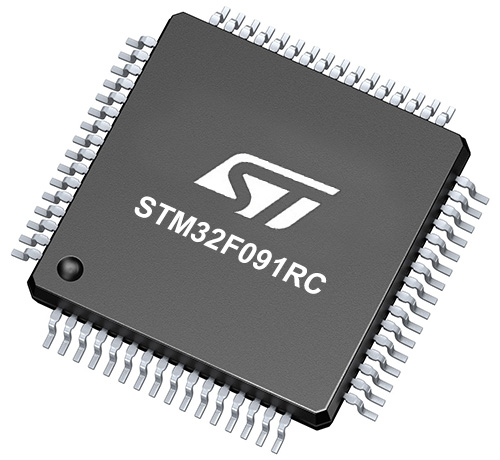
Architecture
ARM Cortex-M0
MCU Memory (KB)
256
Silicon Vendor
STMicroelectronics
Pin count
64
RAM (Bytes)
32768
You complete me!
Accessories
Click Shield for Nucleo-64 comes equipped with two proprietary mikroBUS™ sockets, allowing all the Click board™ devices to be interfaced with the STM32 Nucleo-64 board with no effort. This way, Mikroe allows its users to add any functionality from our ever-growing range of Click boards™, such as WiFi, GSM, GPS, Bluetooth, ZigBee, environmental sensors, LEDs, speech recognition, motor control, movement sensors, and many more. More than 1537 Click boards™, which can be stacked and integrated, are at your disposal. The STM32 Nucleo-64 boards are based on the microcontrollers in 64-pin packages, a 32-bit MCU with an ARM Cortex M4 processor operating at 84MHz, 512Kb Flash, and 96KB SRAM, divided into two regions where the top section represents the ST-Link/V2 debugger and programmer while the bottom section of the board is an actual development board. These boards are controlled and powered conveniently through a USB connection to program and efficiently debug the Nucleo-64 board out of the box, with an additional USB cable connected to the USB mini port on the board. Most of the STM32 microcontroller pins are brought to the IO pins on the left and right edge of the board, which are then connected to two existing mikroBUS™ sockets. This Click Shield also has several switches that perform functions such as selecting the logic levels of analog signals on mikroBUS™ sockets and selecting logic voltage levels of the mikroBUS™ sockets themselves. Besides, the user is offered the possibility of using any Click board™ with the help of existing bidirectional level-shifting voltage translators, regardless of whether the Click board™ operates at a 3.3V or 5V logic voltage level. Once you connect the STM32 Nucleo-64 board with our Click Shield for Nucleo-64, you can access hundreds of Click boards™, working with 3.3V or 5V logic voltage levels.
Used MCU Pins
mikroBUS™ mapper
Take a closer look
Click board™ Schematic

Step by step
Project assembly
Track your results in real time
Application Output
1. Application Output - In Debug mode, the 'Application Output' window enables real-time data monitoring, offering direct insight into execution results. Ensure proper data display by configuring the environment correctly using the provided tutorial.

2. UART Terminal - Use the UART Terminal to monitor data transmission via a USB to UART converter, allowing direct communication between the Click board™ and your development system. Configure the baud rate and other serial settings according to your project's requirements to ensure proper functionality. For step-by-step setup instructions, refer to the provided tutorial.
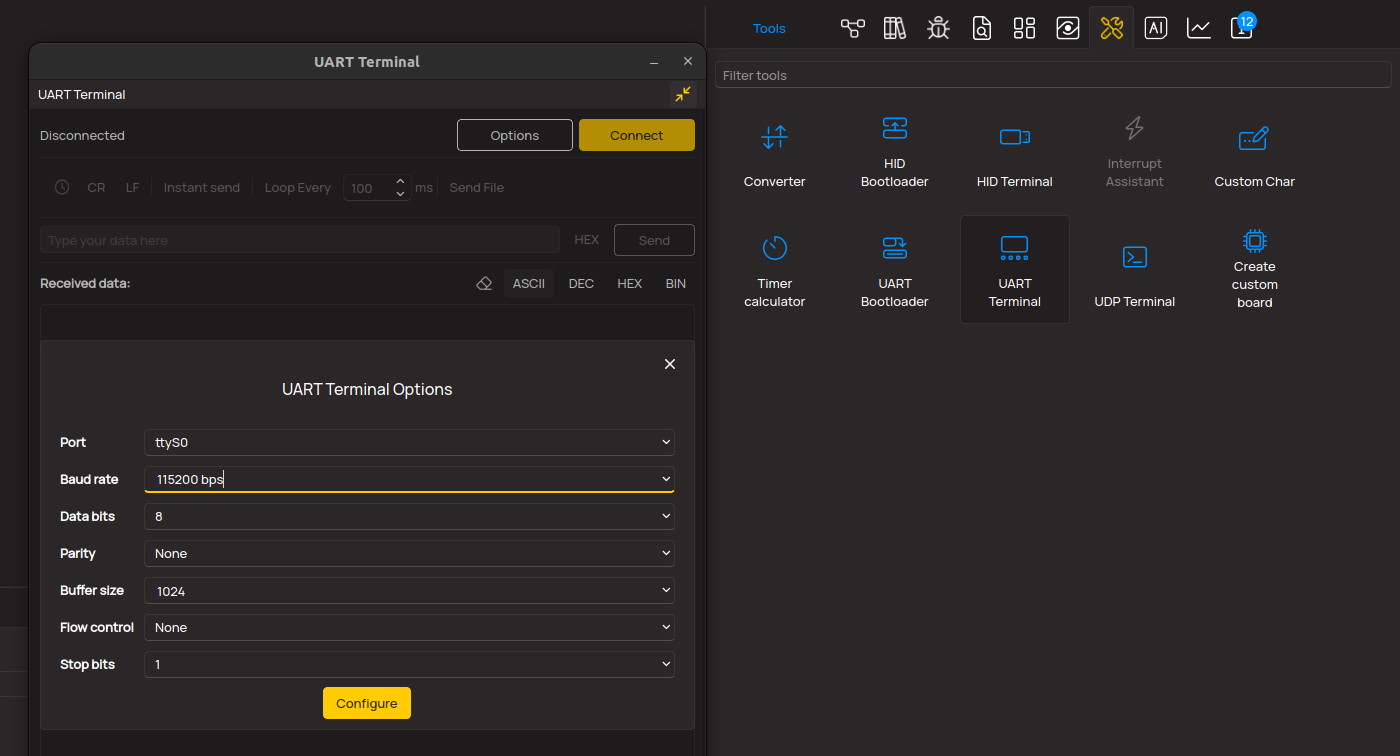
3. Plot Output - The Plot feature offers a powerful way to visualize real-time sensor data, enabling trend analysis, debugging, and comparison of multiple data points. To set it up correctly, follow the provided tutorial, which includes a step-by-step example of using the Plot feature to display Click board™ readings. To use the Plot feature in your code, use the function: plot(*insert_graph_name*, variable_name);. This is a general format, and it is up to the user to replace 'insert_graph_name' with the actual graph name and 'variable_name' with the parameter to be displayed.
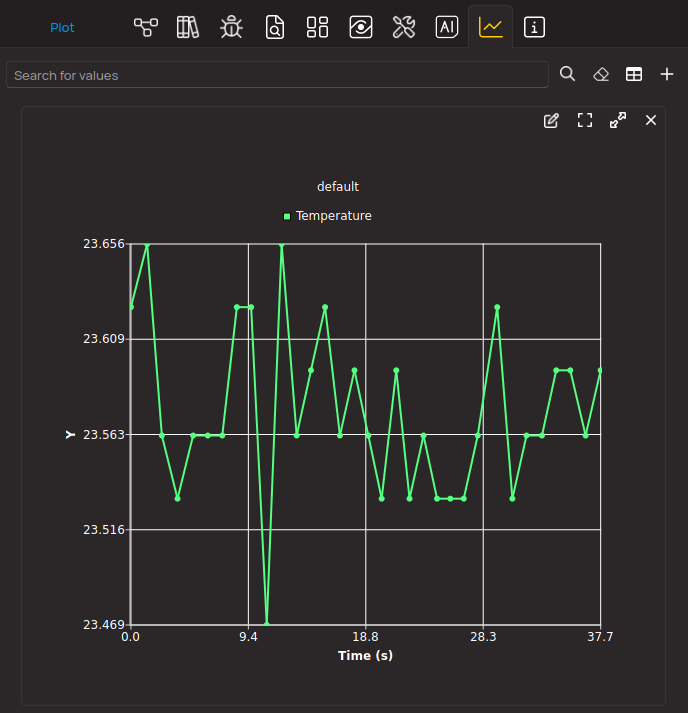
Software Support
Library Description
This library contains API for AudioAmp 3 Click driver.
Key functions:
void audioamp3_cfg_setup ( audioamp3_cfg_t *cfg )- This function power up the audio amplifierAUDIOAMP3_STATUS_T audioamp3_set_play_mode ( audioamp3_t *ctx )- This function set the play mode for all channelsAUDIOAMP3_STATUS_T audioamp3_set_gain_lvl ( audioamp3_t *ctx, uint8_t gain_lvl )- This function set the gain level for all channels
Open Source
Code example
The complete application code and a ready-to-use project are available through the NECTO Studio Package Manager for direct installation in the NECTO Studio. The application code can also be found on the MIKROE GitHub account.
/*!
* \file
* \brief AudioAmp3 Click example
*
* # Description
* AudioAmp 3 Click is a stereo audio amplifier, capable of delivering
* up to 79W per channel with the 4Ω load.
*
* The demo application is composed of two sections :
*
* ## Application Init
* Application Init performs Logger and Click initialization.
*
* ## Application Task
* This is an example which demonstrates the use of AudioAmp 3 Click board.
* In application task function is used that will increase volume of the sound
* from MIN to MAX and reverse.
* Results are being sent to the UART Terminal where you can track their changes.
*
* \author Mihajlo Djordjevic
*
*/
// ------------------------------------------------------------------- INCLUDES
#include "board.h"
#include "log.h"
#include "audioamp3.h"
uint8_t cnt;
uint8_t data_out[ 10 ];
uint8_t status_flag;
// ------------------------------------------------------------------ VARIABLES
static audioamp3_t audioamp3;
static log_t logger;
// ------------------------------------------------------ APPLICATION FUNCTIONS
void application_init ( void )
{
log_cfg_t log_cfg;
audioamp3_cfg_t cfg;
/**
* Logger initialization.
* Default baud rate: 115200
* Default log level: LOG_LEVEL_DEBUG
* @note If USB_UART_RX and USB_UART_TX
* are defined as HAL_PIN_NC, you will
* need to define them manually for log to work.
* See @b LOG_MAP_USB_UART macro definition for detailed explanation.
*/
LOG_MAP_USB_UART( log_cfg );
log_init( &logger, &log_cfg );
log_info( &logger, "---- Application Init ----" );
Delay_ms ( 100 );
// Click initialization.
audioamp3_cfg_setup( &cfg );
AUDIOAMP3_MAP_MIKROBUS( cfg, MIKROBUS_1 );
audioamp3_init( &audioamp3, &cfg );
log_printf( &logger, "--------------------------\r\n\n" );
log_printf( &logger, "--- AudioAmp 3 Click ---\r\n" );
log_printf( &logger, "--------------------------\r\n\n" );
Delay_ms ( 1000 );
audioamp3_power_up( &audioamp3 );
log_printf( &logger, " Power Up \r\n" );
log_printf( &logger, " ---------------------------\r\n\n" );
Delay_100ms();
audioamp3_set_channel_low_to_low( &audioamp3, AUDIOAMP3_MASK_BIT_SEL_CH_1 );
log_printf( &logger, " Set channel 1 low-low state \r\n" );
log_printf( &logger, " ---------------------------\r\n\n" );
Delay_100ms();
audioamp3_set_channel_low_to_low( &audioamp3, AUDIOAMP3_MASK_BIT_SEL_CH_2 );
log_printf( &logger, " Set channel 2 low-low state \r\n" );
log_printf( &logger, " ---------------------------\r\n\n" );
Delay_100ms();
audioamp3_set_channel_mute_mode( &audioamp3, AUDIOAMP3_MASK_BIT_SEL_ALL_CH );
log_printf( &logger, " Mute All Channels \r\n" );
log_printf( &logger, " ---------------------------\r\n\n" );
Delay_100ms();
audioamp3_run_channel_diagnostics( &audioamp3, AUDIOAMP3_MASK_BIT_SEL_ALL_CH );
log_printf( &logger, " Run Diagnostics \r\n" );
log_printf( &logger, " ---------------------------\r\n\n" );
Delay_100ms();
audioamp3_hw_reset( &audioamp3 );
log_printf( &logger, " Hardware Reset \r\n" );
log_printf( &logger, " ---------------------------\r\n\n" );
Delay_100ms();
audioamp3_read_all_diagnostics( &audioamp3, &data_out[ 0 ] );
log_printf( &logger, " Read Diagnostics \r\n" );
log_printf( &logger, " ---------------------------\r\n\n" );
Delay_100ms();
log_printf( &logger, "--------------------------\r\n\n" );
log_printf( &logger, " Initialization done \r\n" );
log_printf( &logger, "--------------------------\r\n\n" );
Delay_ms ( 1000 );
audioamp3_set_play_mode( &audioamp3 );
log_printf( &logger, " ---------------------------\r\n\n" );
log_printf( &logger, " Play \r\n" );
log_printf( &logger, " ---------------------------\r\n\n" );
Delay_100ms();
}
void application_task ( void )
{
for ( cnt = AUDIOAMP3_GAIN_VAL_MIN; cnt < AUDIOAMP3_GAIN_VAL_5; cnt++ )
{
status_flag = audioamp3_set_gain_lvl( &audioamp3, cnt );
log_printf( &logger, " - Volume Up - \r\n" );
Delay_ms ( 1000 );
Delay_ms ( 1000 );
}
log_printf( &logger, " ---------------------------\r\n\n" );
for ( cnt = AUDIOAMP3_GAIN_VAL_MAX; cnt > AUDIOAMP3_GAIN_VAL_0; cnt-- )
{
status_flag = audioamp3_set_gain_lvl( &audioamp3, cnt );
log_printf( &logger, " - Volume Down - \r\n" );
Delay_ms ( 1000 );
Delay_ms ( 1000 );
}
log_printf( &logger, " ---------------------------\r\n\n" );
}
int main ( void )
{
/* Do not remove this line or clock might not be set correctly. */
#ifdef PREINIT_SUPPORTED
preinit();
#endif
application_init( );
for ( ; ; )
{
application_task( );
}
return 0;
}
// ------------------------------------------------------------------------ END
Additional Support
Resources
Category:Amplifier




















